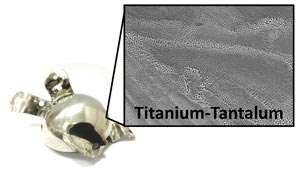Alloys made of either titanium or tantalum hold a massive amount of value within the medical industry, particularly when it comes to 3D printing patient-specific implants. Over the past couple of years we’ve seen titanium alloys geared towards cranial and orthopedic implants, while tantalum has shown a lot of promise for hip replacements and spinal implants. Now, a collaborative team of researchers from A*STAR’s Singapore Institute of Manufacturing Technology (SIMTech) and the Singapore Centre for 3D Printing (SC3DP) at Nanyang Technological University have discovered a viable process to mix the powders into one 3D printable material, which could potentially help 3D print customized, patient-specific implants with enhanced properties and improved stress absorption.
 In order to research these implants, the group utilized selective laser melting (SLM), an emerging 3D printing technology that uses 3D CAD data and high-powered lasers to fuse powdered metal alloys layer-by-layer. The collaborative effort was initiated by SIMTech’s Florencia Edith Wiria and SC3DP’s Wai Yee Yeong, and through their work, they’ve already proved the ability to create biomedical prototypes out of titanium-aluminum-based powders. The issue with aluminum, however, is the potential negative long-term effects that the material could have on human neurology, leading the researchers to turn to an equal mixture of titanium and tantalum alloys.
In order to research these implants, the group utilized selective laser melting (SLM), an emerging 3D printing technology that uses 3D CAD data and high-powered lasers to fuse powdered metal alloys layer-by-layer. The collaborative effort was initiated by SIMTech’s Florencia Edith Wiria and SC3DP’s Wai Yee Yeong, and through their work, they’ve already proved the ability to create biomedical prototypes out of titanium-aluminum-based powders. The issue with aluminum, however, is the potential negative long-term effects that the material could have on human neurology, leading the researchers to turn to an equal mixture of titanium and tantalum alloys.
 Although the combination of these alloys is perfect for implants, particularly due to their biocompatibility and mechanical superiority to standalone titanium, there were still a few kinks to work out with the unique tantalum material. Tantalum, a rare, blue-gray metal, has an extremely high melting point of over 3,000 degrees Celsius, making it difficult and costly to turn the tantalum into finely dispersed microspheres engineered for SLM printing. But by mixing the rough, elongated tantalum powder with a titanium microsphere powder, the researchers were able to use the SLM printing process and retain the spherical shape of the titanium alloy, which was vital to the success of the mixture.
Although the combination of these alloys is perfect for implants, particularly due to their biocompatibility and mechanical superiority to standalone titanium, there were still a few kinks to work out with the unique tantalum material. Tantalum, a rare, blue-gray metal, has an extremely high melting point of over 3,000 degrees Celsius, making it difficult and costly to turn the tantalum into finely dispersed microspheres engineered for SLM printing. But by mixing the rough, elongated tantalum powder with a titanium microsphere powder, the researchers were able to use the SLM printing process and retain the spherical shape of the titanium alloy, which was vital to the success of the mixture.
“The titanium powder acts as a rolling medium,” Wiria explained. “It pushes the tantalum powder along and makes the processing by SLM possible.”
 In order to 3D print these titanium-tantalum prototypes, the researchers needed to reduce the thermal stress of the material, which they succeeded in by applying ‘checkerboard’ laser scanning that melted down the metal materials in alternate up-and-down or side-to-side movements. Not only were the researchers able to show that mixed material was viable and printable, but X-ray and imaging technology actually showed that the addition of the tantalum material and rapid solidification both promoted and stabilized the formation of titanium grains.
In order to 3D print these titanium-tantalum prototypes, the researchers needed to reduce the thermal stress of the material, which they succeeded in by applying ‘checkerboard’ laser scanning that melted down the metal materials in alternate up-and-down or side-to-side movements. Not only were the researchers able to show that mixed material was viable and printable, but X-ray and imaging technology actually showed that the addition of the tantalum material and rapid solidification both promoted and stabilized the formation of titanium grains.
“These alloys are specifically designed for orthopedic applications, and even have the potential to show a type of ‘shape-memory’ after being deformed,” Yeong said. “This opens up the possibilities of printing personalized devices to improve patient care.”
Overall, the research team hypothesizes that the titanium-tantalum could potentially lessen the ’stress shielding’ that often occurs when implants are too elastic, which causes them to transfer insufficient loads to neighboring bones. The research, which is entitled “Selective laser melting of titanium alloy with 50 wt% tantalum: Microstructure and mechanical properties”, was written by Wiria, Yeong, and research collaborator Swee Leong Sing, and was published in the Journal of Alloys and Compounds on March 5, 2016. Discuss the potential for this new material in the 3D Printing with New Titanium Material forum over at 3DPB.com.
[Source: Phys.org]
Subscribe to Our Email Newsletter
Stay up-to-date on all the latest news from the 3D printing industry and receive information and offers from third party vendors.
You May Also Like
US Army Corps of Engineers Taps Lincoln Electric & Eaton for Largest 3D Printed US Civil Works Part
The Soo Locks sit on the US-Canadian border, enabling maritime travel between Lake Superior and Lake Huron, from which ships can reach the rest of the Great Lakes. Crafts carrying...
Construction 3D Printing CEO Reflects on Being Female in Construction
Natalie Wadley, CEO of ChangeMaker3D, could hear the words of her daughter sitting next to her resounding in her head. “Mum, MUM, you’ve won!” Wadley had just won the prestigious...
Blue Laser-powered M600 3D Printer Launched by Meltio
Founded in 2019 as a joint venture between Additec and Sicnova, metal 3D printer OEM Meltio develops and manufactures high-performance and easy-to-use metal 3D printing solutions that use its patented wire-laser metal...
3D Printed Storage Tanks Cut Material Costs by 25%
In a previous article, “Concrete Dreams: Let’s Print Money, Not Houses,” we discussed how the spotlight on 3D printing homes might be misplaced. Bollards, pedestrian bridges, and concrete tanks could...





























